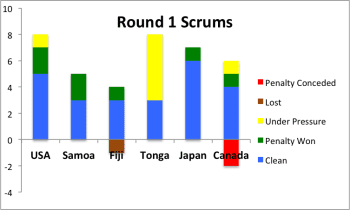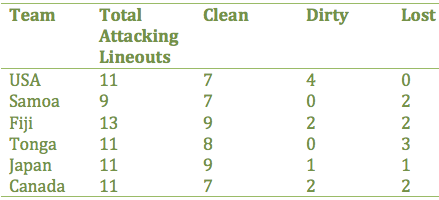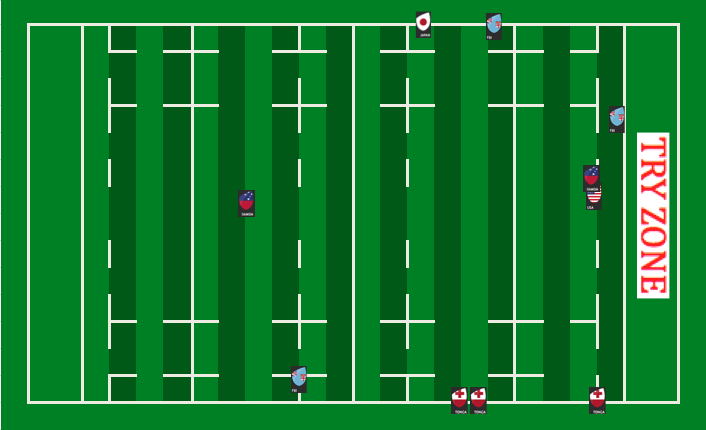
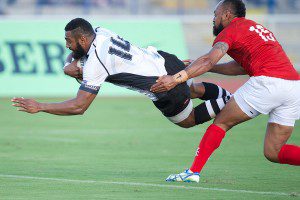
PHILADELPHIA, PA – It has taken some time, what with summer travel and all, but here are the numbers for Round 1 of the Pacific Nations Cup. The plan is to update these 2015 PNC stats after each round so we can look for trends in the tournament as a whole.
Click on any of the tables or charts to make them bigger. For a more general recap of the round, click here.
First up, set pieces. Here are the scrum totals for the first 3 matches. Often, scrum tallies just have won/lost. But scrums won cleanly are not the same as scrums won under pressure, so here they are separated.
The US v Samoa match was pretty even at scrum time. That is a big bonus for the US, given how matches have gone for them in the last few years. The only real difference is that the US had more attacking scrums. In the past, sides have opted to scrum when awarded penalties in the attacking zone, and the Eagles have had to avoid scrummaging. For Eagles’ fans, hopefully this trend of equality will continue.
Fiji did not have an attacking scrum in the second half, but they put Tonga under enough pressure that they didn’t need it. The big number here is the 5 scrums Tonga won under pressure. Several of those ended up putting Fiji on the front foot, and one led to a turnover and a try. This match is proof that a team can “win” a scrum without really “winning” the scrum.
While Japan did not dominate Canada at scrum time in such a way that the Canadian pack were embarrassed, they clearly had the edge in that area of the game.
In the chart below, green and blue are the unequivocally good outcomes, penalties won and clean ball. The unequivocally bad outcomes are below the line.
Things are more complicated at the lineout. There are more variables in terms of both set up and outcome. What is here is the simplest sort of breakout, I think.
I am classifying a lineout won if the team throwing ends up with possession. If it seems that the throw went to the intended receiver, and he was able to get it directly to the intended next man, it is Clean. If the ball was won but seemed not to go to the intended receiver or the intended receiver could not get it to the next man directly, it is Dirty. For now, I am not including penalties (for example, playing the man in the air) as an outcome separate from Clean or Lost, though I know I should and hope to soon.
For now, all lineouts that the throwing team do not win are termed Lost in the table, though in future posts I might differentiate, say, between a clean steal by the opposition and something like a throw not straight.
Here is the breakdown of the round.
The Eagles had a good day at the lineout, though not their best. 4 dirty throws is less precision than they likely need to win any matches in the PNC, but they did have 2 steals.
Perhaps the most interesting thing about the lineouts is actually not captured here: in the Fiji v Tonga match, Tonga used no off-the-top ball. They are the only side for which that is true.
There were two lineouts that I had a tough time seeing during the Japan v Canada game, so it is possible Japan is getting credit for a clean win that wasn’t really clean. And there was a turnover to Canada from a lineout, but I could not see if the turnover happened during the lineout or in a maul after. If you know, feel free to pass the knowledge on and I will make adjustments.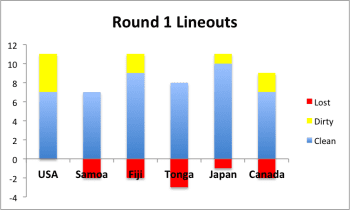

 The other thing I am keeping track of is the starting point of possessions which end in tries. This is new for me, and already tricky. The other thing that is tricky is figuring out how to best present the information. For now, here is a map of the field. Each flag marks the starting point of a possession that ended in a try. For simplicity’s sake, all teams are presented as attacking toward the right hand try zone.
The other thing I am keeping track of is the starting point of possessions which end in tries. This is new for me, and already tricky. The other thing that is tricky is figuring out how to best present the information. For now, here is a map of the field. Each flag marks the starting point of a possession that ended in a try. For simplicity’s sake, all teams are presented as attacking toward the right hand try zone.


 One of the tricky things is the Samoa marker close to the try zone. That was the penalty spot where Alesana Tuilaga took the penalty quickly by kicking cross field to a waiting Ah See Tuala. Strictly, I think the possession started with the penalty. Also true, though, is the fact that the turnover won deep inside the US half was the real spark to the try. In between that turnover and the try was a kick and penalty from the kick-chase. If a team kicks the ball away and does not immediately regather, it seems that the possession has ended and a new one starts when they regain the ball – this time through a penalty.
One of the tricky things is the Samoa marker close to the try zone. That was the penalty spot where Alesana Tuilaga took the penalty quickly by kicking cross field to a waiting Ah See Tuala. Strictly, I think the possession started with the penalty. Also true, though, is the fact that the turnover won deep inside the US half was the real spark to the try. In between that turnover and the try was a kick and penalty from the kick-chase. If a team kicks the ball away and does not immediately regather, it seems that the possession has ended and a new one starts when they regain the ball – this time through a penalty.

 The markers on the touch line indicate that the possession started from a lineout. That means that 5 of 10 tries from the round started with lineouts. 2 started from 5 meter penalties, 2 came from counter attacks from kicks, 1 directly from a turnover.
The markers on the touch line indicate that the possession started from a lineout. That means that 5 of 10 tries from the round started with lineouts. 2 started from 5 meter penalties, 2 came from counter attacks from kicks, 1 directly from a turnover.
5 tries were scored from the first phase. Tonga had the only 2 tries that came after more than 5 phases – tries scored on phase 8 and phase 11.
The sample size for all of this information is, of course, small. It will be interesting to see how things look after Round 2. It would also be great to see how the numbers from the PNC compare to numbers from, say, The Rugby Championship. Fingers crossed.
Feel free to comment below, look for and “Like” our Facebook Rugby Wrap Up Page and follow us on Twitter@: RugbyWrapUp, Junoir Blaber, James Harrington, Jamie Wall, Nick Hall, DJ Eberle, Jake Frechette, Scheenagh Harrington, Jamie Loyd, Cody Kuxmann, Karen Ritter, Audrey Youn, Akweley Okine, Rocky Brown and Declan Yeats, respectively.



